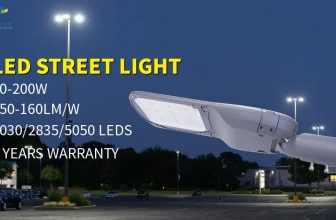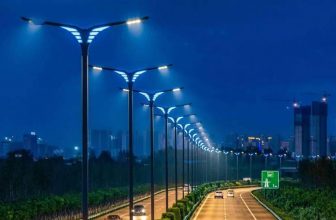Introduction
Street lighting has been an indispensable part of urban infrastructure for centuries. From gas lamps in the 19th century to high-pressure sodium (HPS) lamps in the 20th century, cities have always sought efficient ways to illuminate roads and public spaces. Today, Light Emitting Diode (LED) technology has revolutionized street lighting, offering unprecedented energy efficiency, durability, and adaptability. This article explores the rise of LED street lights, their technical advantages, environmental benefits, challenges, and their role in shaping the future of smart cities.
Table of Contents
- The Emergence of LED Street Lights
- Technical Advantages of LED Technology
- Energy Efficiency and Cost Savings
- Longevity and Reduced Maintenance
- Superior Light Quality and Control
- Environmental Benefits of LED Street Lighting
- Lower Carbon Footprint
- Reduced Light Pollution
- Challenges and Solutions in LED Adoption
- Initial Costs and Funding Models
- Thermal Management and Design Limitations
- Public Acceptance and Aesthetic Concerns
- LEDs and Smart City Integration
- IoT-Enabled Adaptive Lighting Systems
- Solar-Powered LED Street Lights
- Data Collection and Urban Planning
- Global Case Studies
- Los Angeles, USA: A Model for Large-Scale LED Conversion
- Copenhagen, Denmark: Achieving Carbon Neutrality with LEDs
- Mumbai, India: Solar-LED Hybrid Systems in Developing Cities
- Future Trends in LED Street Lighting
- Li-Fi Integration for Wireless Communication
- AI-Driven Predictive Maintenance
- Advanced Materials for Enhanced Efficiency
- Conclusion
1. The Emergence of LED Street Lights
The transition to LED street lighting began in earnest in the early 2000s, driven by advancements in semiconductor technology and growing environmental awareness. Unlike traditional lighting systems, LEDs convert over 80% of electrical energy into light, minimizing waste heat. Governments and municipalities worldwide have since prioritized LED adoption as part of sustainability initiatives. For instance, the U.S. Department of Energy estimates that replacing HPS lamps with LEDs could save cities up to 50–70% in energy costs.
2. Technical Advantages of LED Technology
Energy Efficiency and Cost Savings
LEDs consume significantly less power than HPS or metal halide lamps. A typical 100W LED fixture can replace a 250W HPS lamp while delivering the same luminance (measured in lumens). This efficiency translates to direct savings on electricity bills. For example, New York City’s LED retrofit project, completed in 2017, saves taxpayers $14 million annually in energy costs.
Longevity and Reduced Maintenance
LED street lights boast lifespans of 50,000–100,000 hours, compared to 10,000–24,000 hours for HPS lamps. This reduces maintenance frequency, lowering labor costs and traffic disruptions. Phoenix, Arizona, reported a 60% drop in maintenance requests after switching to LEDs.
Superior Light Quality and Control
LEDs provide uniform, glare-free illumination with high Color Rendering Index (CRI) scores, enhancing visibility and safety. Modern LEDs also allow dimming and motion-sensing capabilities, enabling adaptive lighting that responds to pedestrian or vehicular activity.
3. Environmental Benefits of LED Street Lighting
Lower Carbon Footprint
By slashing energy consumption, LEDs reduce reliance on fossil fuels. The Global Lighting Association states that global LED adoption could cut CO2 emissions by 1.4 billion tons annually by 2030.
Reduced Light Pollution
Traditional streetlights often scatter light upward, contributing to “skyglow.” LEDs can be directional, focusing light downward. Dark-sky compliant LED fixtures are now mandatory in cities like Tucson, Arizona, to protect astronomical research and wildlife.
4. Challenges and Solutions in LED Adoption
Initial Costs and Funding Models
While LEDs save money long-term, upfront costs remain a barrier. Solutions include public-private partnerships (PPPs) and energy-saving performance contracts (ESPCs), where vendors cover installation costs in exchange for a share of the savings.
Thermal Management and Design Limitations
LEDs degrade faster in high temperatures. Advanced heat sinks and passive cooling designs have mitigated this issue. For instance, Philips’ LumiStreet series uses aerodynamically designed housings to dissipate heat efficiently.
Public Acceptance and Aesthetic Concerns
Some communities resist LEDs due to their cooler color temperatures (4000K–5000K). Cities like Amsterdam now offer tunable LEDs that mimic warmer tones (2700K) in historic districts.
5. LEDs and Smart City Integration
IoT-Enabled Adaptive Lighting Systems
Cities like Barcelona embed sensors in LED fixtures to adjust brightness based on real-time data. During low-traffic hours, lights dim to 30%, saving energy without compromising safety.
Solar-Powered LED Street Lights
Off-grid solar-LED systems are transforming rural areas. India’s Smart Cities Mission has installed over 500,000 solar-LED streetlights, reducing diesel generator dependence.
Data Collection and Urban Planning
LEDs with embedded cameras and air quality sensors provide data for traffic management and pollution monitoring. Singapore’s Smart Nation initiative uses this data to optimize public transport routes.
6. Global Case Studies
Los Angeles, USA
LA replaced 140,000 streetlights with LEDs by 2013, cutting energy use by 63% and saving $10 million yearly. The project’s success inspired similar initiatives in Seattle and Paris.
Copenhagen, Denmark
Copenhagen’s LED network, integrated with wind energy, supports its goal to become carbon-neutral by 2025. Adaptive lighting reduces energy use by 57% in residential zones.
Mumbai, India
Mumbai’s hybrid solar-LED system powers 88,000 streetlights, slashing CO2 emissions by 12,000 tons annually. The project also created jobs in local LED manufacturing.
7. Future Trends in LED Street Lightin
Li-Fi Integration for Wireless Communication
Li-Fi (Light Fidelity) uses LED flicker to transmit data at speeds up to 224 Gbps. Pilot projects in Estonia provide free internet access via streetlights.
AI-Driven Predictive Maintenance
Machine learning algorithms analyze usage patterns to predict fixture failures. Boston’s pilot program reduced outage response times by 40%.
Advanced Materials for Enhanced Efficiency
Perovskite-based LEDs, with efficiencies exceeding 200 lumens per watt, could redefine performance standards by 2030.
8. Conclusion
LED street lighting is more than an upgrade—it’s a cornerstone of sustainable urban development. By merging energy efficiency with smart technology, LEDs are paving the way for safer, greener, and more connected cities. As innovations like Li-Fi and AI-driven systems mature, the humble streetlight will evolve into a multifunctional asset, proving that even the smallest light can illuminate a brighter future.






